Photocatalytic Activity and Reusability of F, Sm3+ Co-Doped TiO2/MWCNTs Hybrid Heterostructure for Efficient Photocatalytic Degradation of Brilliant Black Bis-Azo Dye
Abstract
1. Introduction
2. Results
2.1. Characteristics of MWCNT /F, Sm3+ Co-Doped TiO2
2.1.1. Surface Functional Groups
2.1.2. Optical Properties
2.1.3. Thermal Properties
2.1.4. Crystallinity
2.1.5. Surface Morphology and Elemental Composition
2.1.6. Internal Morphology
2.1.7. Specific Surface Area
3. Discussion
3.1. Photodegradation Studies
3.2. Reusability of the Photocatalyst
3.3. Total Organic Carbon
4. Materials and Methods
4.1. Materials
4.2. Functionalisation of MWCNTs
4.3. Preparation MWCNT/F, Sm3+ Co-Doped TiO2 (0.6% Sm3+)
4.4. Material Characterisation
4.4.1. Fourier Transform Infrared Spectroscopy and Raman Spectroscopy
4.4.2. Ultraviolet-Visible Spectroscopy
4.4.3. Microscopy
4.4.4. Thermogravimetric Analysis
4.4.5. X-ray Diffraction Analysis
4.4.6. Specific Surface Area
4.5. Evaluation of Catalytic Activity
4.6. Catalyst Reusability
5. Perspectives, Future Outlook and Prospective Studies
6. Conclusions
Author Contributions
Funding
Data Availability Statement
Acknowledgments
Conflicts of Interest
References
- Pandis, P.K.; Kalogirou, C.; Kanellou, E.; Vaitsis, C.; Savvidou, M.G.; Sourkouni, G.; Zorpas, A.A.; Argirusis, C. Key Points of Advanced Oxidation Processes (AOPs) for Wastewater, Organic Pollutants and Pharmaceutical Waste Treatment: A Mini Review. Chemengineering 2022, 6, 8. [Google Scholar] [CrossRef]
- Guo, W.; Pan, B.; Sakkiah, S.; Yavas, G.; Ge, W.; Zou, W.; Tong, W.; Hong, H. Persistent Organic Pollutants in Food: Contamination Sources, Health Effects and Detection Methods. Int. J. Environ. Res. Public Health 2019, 16, 4361. [Google Scholar] [CrossRef] [PubMed]
- Babu, B.R.; Parande, A.K.; Raghu, S.; Kumar, T.P. Cotton textile processing: Waste generation and effluent treatment. J. Cotton Sci. 2007, 11, 141–153. [Google Scholar]
- Kouvelis, K.; Kampioti, A.A.; Petala, A.; Frontistis, Z. Degradation of Sulfamethoxazole Using a Hybrid CuOx–BiVO4/SPS/Solar System. Catalysts 2022, 12, 882. [Google Scholar] [CrossRef]
- Rekhate, C.V.; Srivastava, J.K. Recent advances in ozone-based advanced oxidation processes for treatment of wastewater- A review. Chem. Eng. J. Adv. 2020, 3, 100031. [Google Scholar] [CrossRef]
- Luttrell, T.; Halpegamage, S.; Tao, J.; Kramer, A.; Sutter, E.; Batzill, M. Why is anatase a better photocatalyst than rutile?—Model studies on epitaxial TiO2 films. Sci. Rep. 2014, 4, 4043. [Google Scholar] [CrossRef] [PubMed]
- Sang, Y.; Liu, H.; Umar, A. Photocatalysis from UV/Vis to Near-Infrared Light: Towards Full Solar-Light Spectrum Activity. Chemcatchem 2015, 7, 559–573. [Google Scholar] [CrossRef]
- Szabó, T.; Veres, Á.; Cho, E.; Khim, J.; Varga, N.; Dékány, I. Photocatalyst separation from aqueous dispersion using graphene oxide/TiO2 nanocomposites. Colloids Surf. A Physicochem. Eng. Asp. 2013, 433, 230–239. [Google Scholar] [CrossRef]
- Wang, C.M.; Mallouk, T.E. Wide-range tuning of the titanium dioxide flat-band potential by adsorption of fluoride and hydrofluoric acid. J. Phys. Chem. 1990, 94, 4276–4280. [Google Scholar] [CrossRef]
- Ibrahim, H.H.; Mohamed, A.A.; Ibrahim, I.A. Electronic and optical properties of mono and co-doped anatase TiO2: First principles calculations. Mater. Chem. Phys. 2020, 252, 123285. [Google Scholar] [CrossRef]
- Chen, Y.; Li, A.; Fu, X.; Peng, Z. Electrospinning-based (N,F)-co-doped TiO2-δ nanofibers: An excellent photocatalyst for degrading organic dyes and heavy metal ions under visible light. Mater. Chem. Phys. 2022, 291, 126672. [Google Scholar] [CrossRef]
- Bai, J.; Zhou, B.; Li, L.; Liu, Y.; Zheng, Q.; Shao, J.; Zhu, X.; Cai, W.; Liao, J.; Zou, L. The formation mechanism of titania nanotube arrays in hydrofluoric acid electrolyte. J. Mater. Sci. 2008, 43, 1880–1884. [Google Scholar] [CrossRef]
- Liu, S.; Yu, J.; Jaroniec, M. Anatase TiO2 with Dominant High-Energy {001} Facets: Synthesis, Properties, and Applications. Chem. Mater. 2011, 23, 4085–4093. [Google Scholar] [CrossRef]
- Todorova, N.; Giannakopoulou, T.; Romanos, G.; Vaimakis, T.; Yu, J.; Trapalis, C. Preparation of Fluorine-Doped TiO2 Photocatalysts with Controlled Crystalline Structure. Int. J. Photoenergy 2008, 2008, 534038. [Google Scholar] [CrossRef]
- Tang, J.; Quan, H.; Ye, J. Photocatalytic Properties and Photoinduced Hydrophilicity of Surface-Fluorinated TiO2. Chem. Mater. 2006, 19, 116–122. [Google Scholar] [CrossRef]
- Li, S.; Hennigan, J.M.; Dixon, D.A.; Peterson, K.A. Accurate Thermochemistry for Transition Metal Oxide Clusters. J. Phys. Chem. A 2009, 113, 7861–7877. [Google Scholar] [CrossRef] [PubMed]
- Buddee, S.; Wongnawa, S.; Sirimahachai, U.; Puetpaibool, W. Recyclable UV and visible light photocatalytically active amorphous TiO2 doped with M (III) ions (M = Cr and Fe). Mater. Chem. Phys. 2011, 126, 167–177. [Google Scholar] [CrossRef]
- Štengl, V.; Bakardjieva, S.; Murafa, N. Preparation and photocatalytic activity of rare earth doped TiO2 nanoparticles. Mater. Chem. Phys. 2009, 114, 217–226. [Google Scholar] [CrossRef]
- Huang, D.; Ying, F.; Chen, S.; Zhou, C.; Su, P.; Wu, W. Metal–Ligand Bonds in Rare Earth Metal–Biphenyl Complexes. Inorg. Chem. 2022, 61, 8135–8143. [Google Scholar] [CrossRef]
- Ji, T.; Liu, Y.; Zhao, H.; Du, H.; Sun, J.; Ge, G. Preparation and up-conversion fluorescence of rare earth (Er3+ or Yb3+/Er3+)-doped TiO2 nanobelts. J. Solid State Chem. 2010, 183, 584–589. [Google Scholar] [CrossRef]
- Cho, H.; Joo, H.; Kim, H.; Kim, J.-E.; Kang, K.-S.; Jung, H.; Yoon, J. Enhanced Photoelectrochemical Activity of TiO2 Nanotubes Decorated with Lanthanide Ions for Hydrogen Production. Catalysts 2022, 12, 866. [Google Scholar] [CrossRef]
- Kataura, H.; Kumazawa, Y.; Maniwa, Y.; Umezu, I.; Suzuki, S.; Ohtsuka, Y.; Achiba, Y. Optical properties of single-wall carbon nanotubes. Synth. Met. 1999, 103, 2555–2558. [Google Scholar] [CrossRef]
- Yen, C.-Y.; Lin, Y.-F.; Hung, C.-H.; Tseng, Y.-H.; Ma, C.-C.M.; Chang, M.-C.; Shao, H. The effects of synthesis procedures on the morphology and photocatalytic activity of multi-walled carbon nanotubes/TiO2 nanocomposites. Nanotechnology 2008, 19, 045604. [Google Scholar] [CrossRef] [PubMed]
- Zhao, C.; Guo, J.; Yu, C.; Zhang, Z.; Sun, Z.; Piao, X. Fabrication of CNTs-Ag-TiO2 ternary structure for enhancing visible light photocatalytic degradation of organic dye pollutant. Mater. Chem. Phys. 2020, 248, 122873. [Google Scholar] [CrossRef]
- Lam, S.-M.; Sin, J.-C.; Mohamed, A.R. Parameter effect on photocatalytic degradation of phenol using TiO2-P25/activated carbon (AC). Korean J. Chem. Eng. 2010, 27, 1109–1116. [Google Scholar] [CrossRef]
- Jiang, T.; Zhang, L.; Ji, M.; Wang, Q.; Zhao, Q.; Fu, X.; Yin, H. Carbon nanotubes/TiO2 nanotubes composite photocatalysts for efficient degradation of methyl orange dye. Particuology 2013, 11, 737–742. [Google Scholar] [CrossRef]
- Yang, H.M.; Park, S.-J. Effect of incorporation of multiwalled carbon nanotubes on photodegradation efficiency of mesoporous anatase TiO2 spheres. Mater. Chem. Phys. 2017, 186, 261–270. [Google Scholar] [CrossRef]
- Wang, H.; Dong, S.; Chang, Y.; Faria, J.L. Enhancing the photocatalytic properties of TiO2 by coupling with carbon nanotubes and supporting gold. J. Hazard. Mater. 2012, 235–236, 230–236. [Google Scholar] [CrossRef]
- Zhao, D.; Yang, X.; Chen, C.; Wang, X. Enhanced photocatalytic degradation of methylene blue on multiwalled carbon nanotubes–TiO2. J. Colloid Interface Sci. 2013, 398, 234–239. [Google Scholar] [CrossRef]
- Kuvarega, A.T.; Krause, R.W.M.; Mamba, B.B. Nitrogen/Palladium-Codoped TiO2 for Efficient Visible Light Photocatalytic Dye Degradation. J. Phys. Chem. C 2011, 115, 22110–22120. [Google Scholar] [CrossRef]
- Mamba, G.; Mamo, M.A.; Mbianda, X.Y.; Mishra, A.K. Nd,N,S-TiO2 Decorated on Reduced Graphene Oxide for a Visible Light Active Photocatalyst for Dye Degradation: Comparison to Its MWCNT/Nd,N,S-TiO2 Analogue. Ind. Eng. Chem. Res. 2014, 53, 14329–14338. [Google Scholar] [CrossRef]
- Mamba, G.; Mbianda, X.Y.; Mishra, A.K. Gadolinium nanoparticle-decorated multiwalled carbon nanotube/titania nanocomposites for degradation of methylene blue in water under simulated solar light. Environ. Sci. Pollut. Res. 2014, 21, 5597–5609. [Google Scholar] [CrossRef] [PubMed]
- Nguyen, K.C.; Ngoc, M.P.; Van Nguyen, M. Enhanced photocatalytic activity of nanohybrids TiO2 /CNTs materials. Mater. Lett. 2016, 165, 247–251. [Google Scholar] [CrossRef]
- Chen, J.S.; Tan, Y.L.; Li, C.M.; Cheah, Y.L.; Luan, D.; Madhavi, S.; Boey, F.Y.C.; Archer, L.A.; Lou, X.W. Constructing Hierarchical Spheres from Large Ultrathin Anatase TiO2 Nanosheets with Nearly 100% Exposed (001) Facets for Fast Reversible Lithium Storage. J. Am. Chem. Soc. 2010, 132, 6124–6130. [Google Scholar] [CrossRef] [PubMed]
- Shanmugharaj, A.; Bae, J.; Lee, K.Y.; Noh, W.H.; Lee, S.H.; Ryu, S.H. Physical and chemical characteristics of multiwalled carbon nanotubes functionalized with aminosilane and its influence on the properties of natural rubber composites. Compos. Sci. Technol. 2007, 67, 1813–1822. [Google Scholar] [CrossRef]
- Kuvarega, A.; Krause, R.W.M.; Mamba, B. Multiwalled carbon nanotubes decorated with nitrogen, palladium co-doped TiO2 (MWCNT/N, Pd co-doped TiO2) for visible light photocatalytic degradation of Eosin Yellow in water. J. Nanopart. Res. 2012, 14, 776. [Google Scholar] [CrossRef]
- Koli, V.B.; Dhodamani, A.G.; Delekar, S.D.; Pawar, S.H. In situ sol-gel synthesis of anatase TiO2 -MWCNTs nanocomposites and their photocatalytic applications. J. Photochem. Photobiol. A Chem. 2017, 333, 40–48. [Google Scholar] [CrossRef]
- Mamba, G.; Mbianda, X.; Mishra, A. Enhanced visible light photocatalytic degradation of eriochrome black T and eosin blue shade in water using tridoped titania decorated on SWCNTs and MWCNTs: Effect of the type of carbon nanotube incorporated. Mater. Chem. Phys. 2015, 149–150, 734–742. [Google Scholar] [CrossRef]
- Popov, V.N. Carbon nanotubes: Properties and application. Mater. Sci. Eng. R Rep. 2004, 43, 61–102. [Google Scholar] [CrossRef]
- Xu, Y.-J.; Zhuang, Y.; Fu, X. New Insight for Enhanced Photocatalytic Activity of TiO2 by Doping Carbon Nanotubes: A Case Study on Degradation of Benzene and Methyl Orange. J. Phys. Chem. C 2010, 114, 2669–2676. [Google Scholar] [CrossRef]
- Wu, C.-H.; Kuo, C.-Y.; Chen, S.-T. Synergistic effects between TiO2 and carbon nanotubes (CNTs) in a TiO2/CNTs system under visible light irradiation. Environ. Technol. 2013, 34, 2513–2519. [Google Scholar] [CrossRef] [PubMed]
- Teixeira, S.; Martins, P.M.; Lanceros-Mendez, S.; Kühn, K.; Cuniberti, G. Reusability of photocatalytic TiO2 and ZnO nanoparticles immobilized in poly(vinylidene difluoride)-co-trifluoroethylene. Appl. Surf. Sci. 2016, 384, 497–504. [Google Scholar] [CrossRef]
- Tian, L.; Ye, L.; Deng, K.; Zan, L. TiO2/carbon nanotube hybrid nanostructures: Solvothermal synthesis and their visible light photocatalytic activity. J. Solid State Chem. 2011, 184, 1465–1471. [Google Scholar] [CrossRef]
- Hamadanian, M.; Jabbari, V.; Shamshiri, M.; Asad, M.; Mutlay, I. Preparation of novel hetero-nanostructures and high efficient visible light-active photocatalyst using incorporation of CNT as an electron-transfer channel into the support TiO2 and PbS. J. Taiwan Inst. Chem. Eng. 2013, 44, 748–757. [Google Scholar] [CrossRef]
- Du, Y.; Niu, X.; Li, W.; Liu, J.; Li, J. Synthesis of High-Energy Faceted TiO2 Nanocrystals with Enhanced Photocatalytic Performance for the Removal of Methyl Orange. Catalysts 2022, 12, 1534. [Google Scholar] [CrossRef]
- Mamba, G.; Mbianda, X.Y.; Mishra, A.K. Photocatalytic degradation of the diazo dye naphthol blue black in water using MWCNT/Gd,N,S-TiO2 nanocomposites under simulated solar light. J. Environ. Sci. 2015, 33, 219–228. [Google Scholar] [CrossRef]
- Zhou, H.; Qiu, Y.; Yang, C.; Zang, J.; Song, Z.; Yang, T.; Li, J.; Fan, Y.; Dang, F.; Wang, W. Efficient Degradation of Congo Red in Water by UV-Vis Driven CoMoO4/PDS Photo-Fenton System. Molecules 2022, 27, 8642. [Google Scholar] [CrossRef]
- Solís, M.; Solís, A.; Pérez, H.I.; Manjarrez, N.; Flores, M. Microbial decolouration of azo dyes: A review. Process. Biochem. 2012, 47, 1723–1748. [Google Scholar] [CrossRef]
- Wang, W.; Serp, P.; Kalck, P.; Faria, J.L. Visible light photodegradation of phenol on MWNT-TiO2 composite catalysts prepared by a modified sol–gel method. J. Mol. Catal. A Chem. 2005, 235, 194–199. [Google Scholar] [CrossRef]
- Leary, R.; Westwood, A. Carbonaceous nanomaterials for the enhancement of TiO2 photocatalysis. Carbon 2011, 49, 741–772. [Google Scholar] [CrossRef]
- Czech, B.; Buda, W. Photocatalytic treatment of pharmaceutical wastewater using new multiwall-carbon nanotubes/TiO2/SiO2 nanocomposites. Environ. Res. 2015, 137, 176–184. [Google Scholar] [CrossRef] [PubMed]
- Wu, C.-Y.; Tu, K.-J.; Deng, J.-P.; Lo, Y.-S.; Wu, C.-H. Markedly Enhanced Surface Hydroxyl Groups of TiO2 Nanoparticles with Superior Water-Dispersibility for Photocatalysis. Materials 2017, 10, 566. [Google Scholar] [CrossRef]
- Sun, K.; Vasudev, M.; Jung, H.-S.; Yang, J.; Kar, A.; Li, Y.; Reinhardt, K.; Snee, P.; Stroscio, M.A.; Dutta, M. Applications of colloidal quantum dots. Microelectron. J. 2009, 40, 644–649. [Google Scholar] [CrossRef]
- Hunge, Y.M.; Yadav, A.A.; Kang, S.-W. Photocatalytic Degradation of Eriochrome Black-T Using BaWO4/MoS2 Composite. Catalysts 2022, 12, 1290. [Google Scholar] [CrossRef]
- Hisaindee, S.; Meetani, M.; Rauf, M. Application of LC-MS to the analysis of advanced oxidation process (AOP) degradation of dye products and reaction mechanisms. TrAC Trends Anal. Chem. 2013, 49, 31–44. [Google Scholar] [CrossRef]
- Larkin, P. General outline and strategies for IR and Raman spectral interpretation. In Infrared and Raman Spectroscopy: Principles and Spectral Interpretation, 1st ed.; Larkin, P., Ed.; Elsevier: London, UK, 2011; pp. 117–133. [Google Scholar]
- Skalska, K.; Malankowska, A.; Balcerzak, J.; Gazda, M.; Nowaczyk, G.; Jurga, S.; Zaleska-Medynska, A. NOx Photooxidation over Different Noble Metals Modified TiO2. Catalysts 2022, 12, 857. [Google Scholar] [CrossRef]
- Wang, Y.; Yu, Q.; Xue, L.; Yu, Q.; Zhu, X. Selective Synthesis of 1,4-Dioxane from Oxirane Dimerization over ZrO2/TiO2 Catalyst at Low Temperature. Catalysts 2022, 12, 832. [Google Scholar] [CrossRef]
- Dalhatou, S.; Sali, M.; Tetteh, S.; Boubakari, A.; Talami, B.; Zeghioud, H.; Kane, A.; El Jery, A.; Assadi, A.A.; Obada, D.O. Sorbent and Photocatalytic Potentials of Local Clays for the Removal of Organic Xenobiotic: Case of Crystal Violet. Catalysts 2022, 12, 899. [Google Scholar] [CrossRef]
- Hunge, Y.; Yadav, A.; Dhodamani, A.; Suzuki, N.; Terashima, C.; Fujishima, A.; Mathe, V. Enhanced photocatalytic performance of ultrasound treated GO/TiO2 composite for photocatalytic degradation of salicylic acid under sunlight illumination. Ultrason. Sonochem. 2020, 61, 104849. [Google Scholar] [CrossRef] [PubMed]
- Sun, M.; Senthil, R.A.; Pan, J.; Osman, S.; Khan, A. A Facile Synthesis of Visible-Light Driven Rod-on-Rod like α-FeOOH/α-AgVO3 Nanocomposite as Greatly Enhanced Photocatalyst for Degradation of Rhodamine B. Catalysts 2018, 8, 392. [Google Scholar] [CrossRef]
- Osman, N.; Sulaiman, S.; Muhamad, E.; Mukhair, H.; Tan, S.; Abdullah, A. Synthesis of an Ag3PO4/Nb2O5 Photocatalyst for the Degradation of Dye. Catalysts 2021, 11, 458. [Google Scholar] [CrossRef]
- Amano, F.; Yamamoto, A.; Kumagai, J. Highly Active Rutile TiO2 for Photocatalysis under Violet Light Irradiation at 405 nm. Catalysts 2022, 12, 1079. [Google Scholar] [CrossRef]
- Sakar, M.; Prakash, R.M.; Do, T.-O. Insights into the TiO2-Based Photocatalytic Systems and Their Mechanisms. Catalysts 2019, 9, 680. [Google Scholar] [CrossRef]
- Jia, L.; Li, F.; Yang, C.; Yang, X.; Kou, B.; Xing, Y.; Peng, J.; Ni, G.; Cao, Z.; Zhang, S.; et al. Direct Z-Scheme Heterojunction α-MnO2/BiOI with Oxygen-Rich Vacancies Enhanced Photoelectrocatalytic Degradation of Organic Pollutants under Visible Light. Catalysts 2022, 12, 1596. [Google Scholar] [CrossRef]
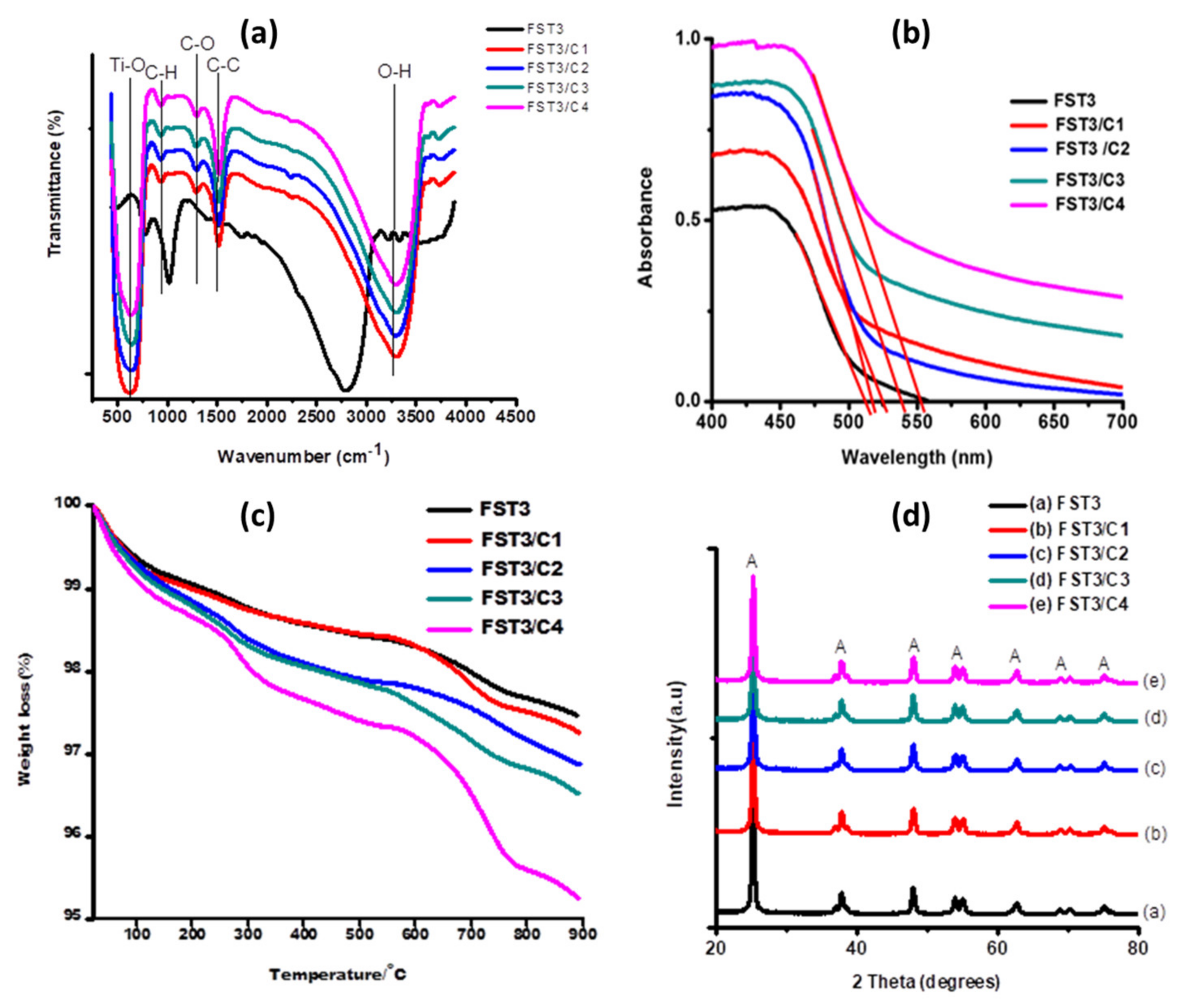
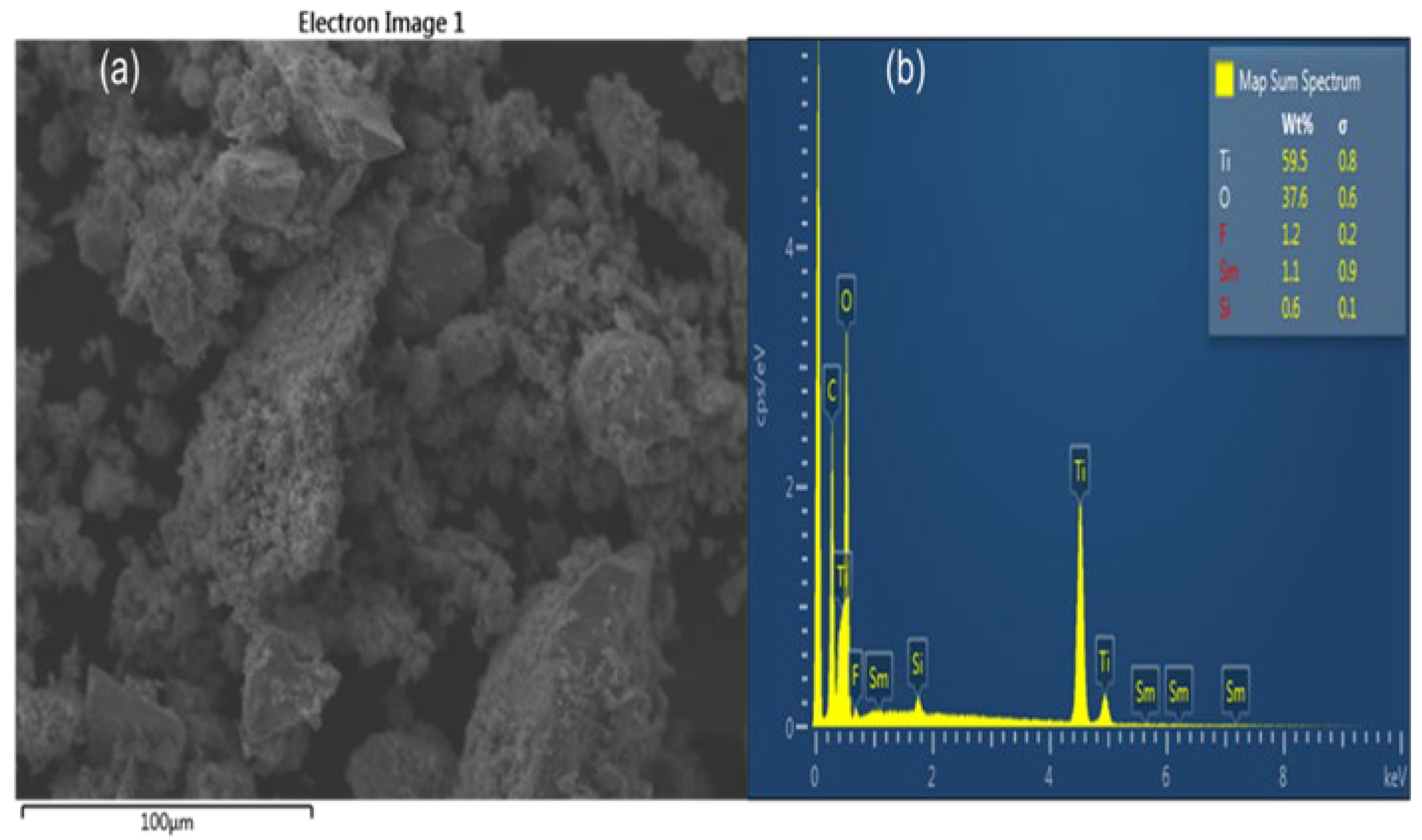
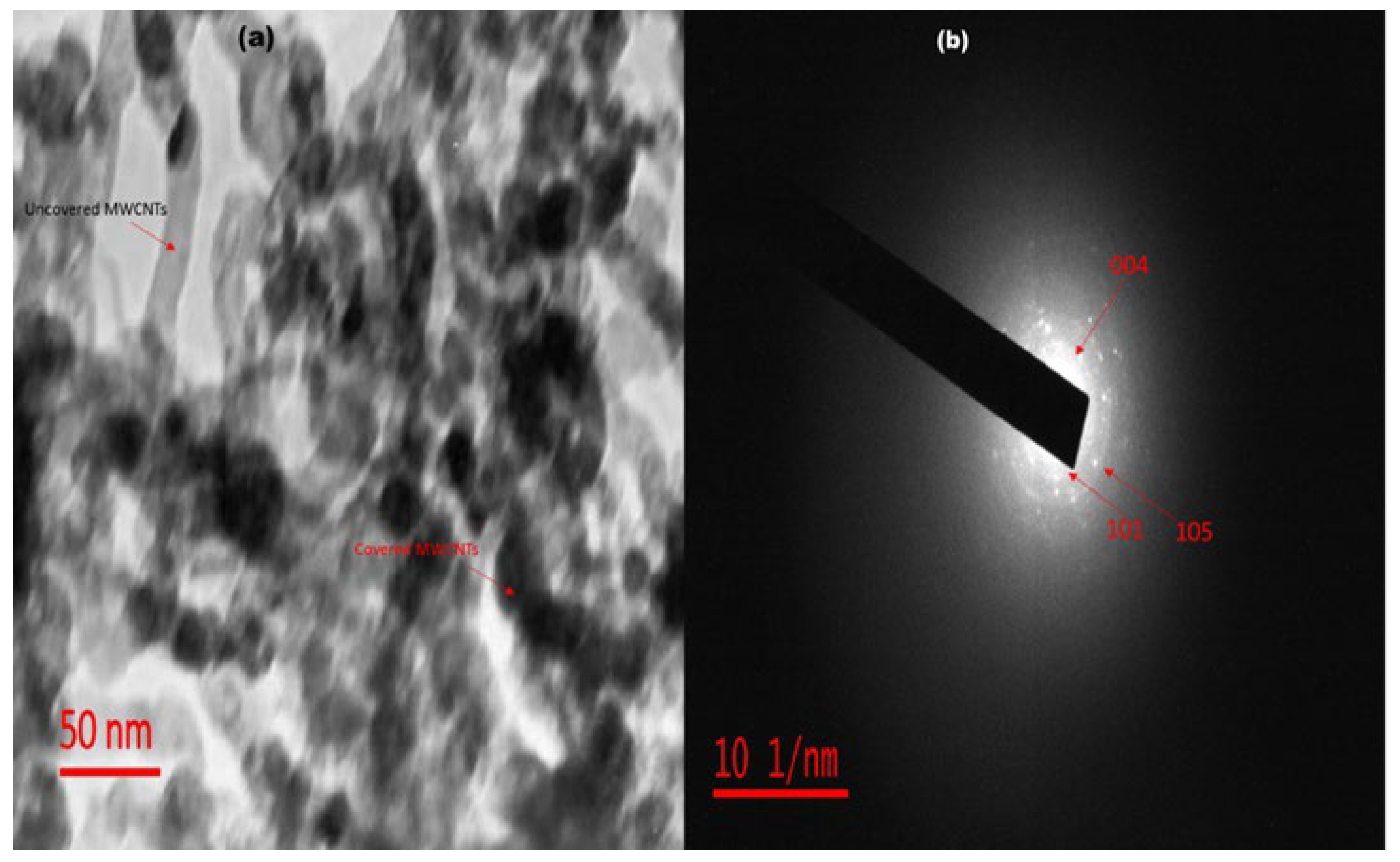

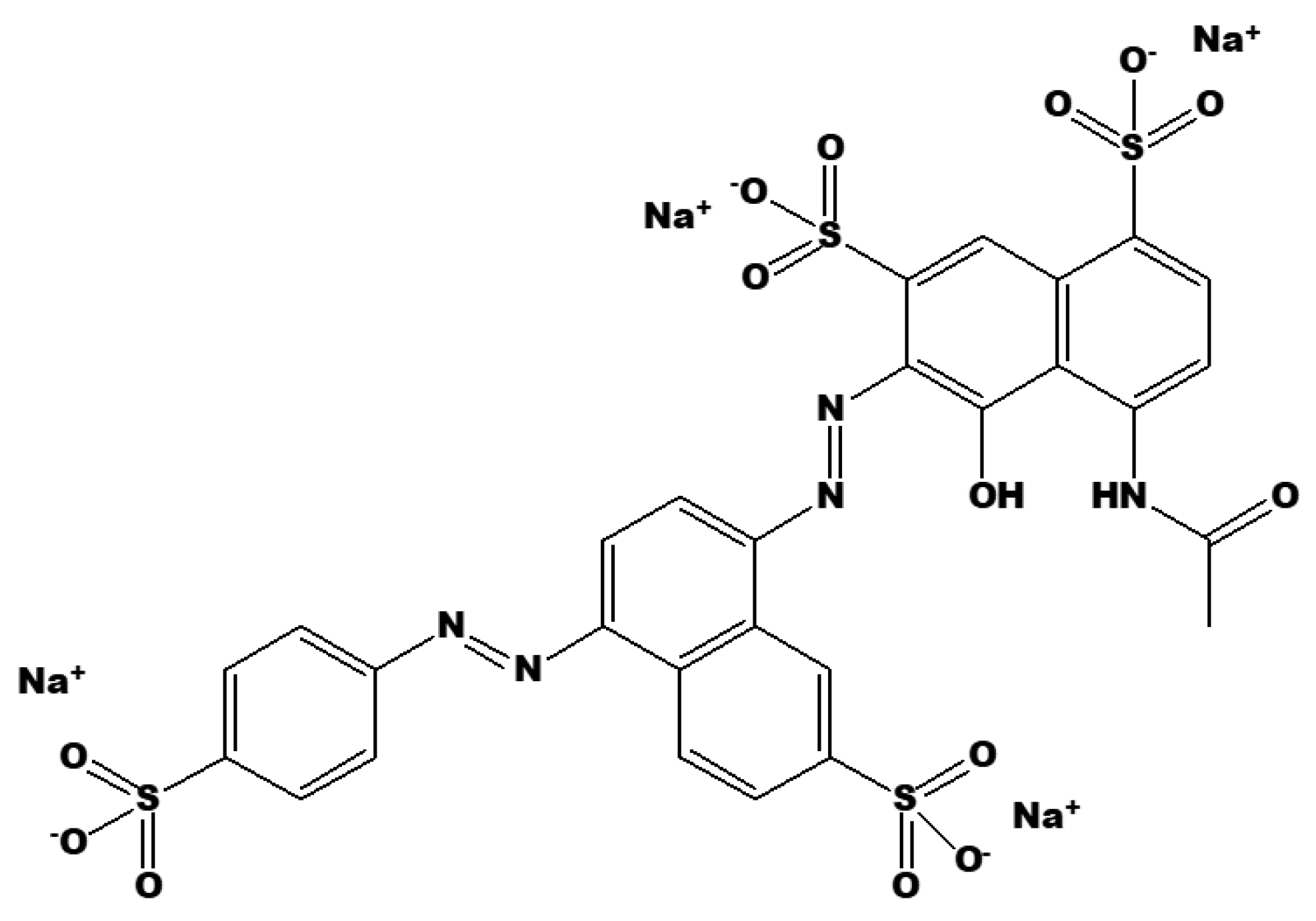
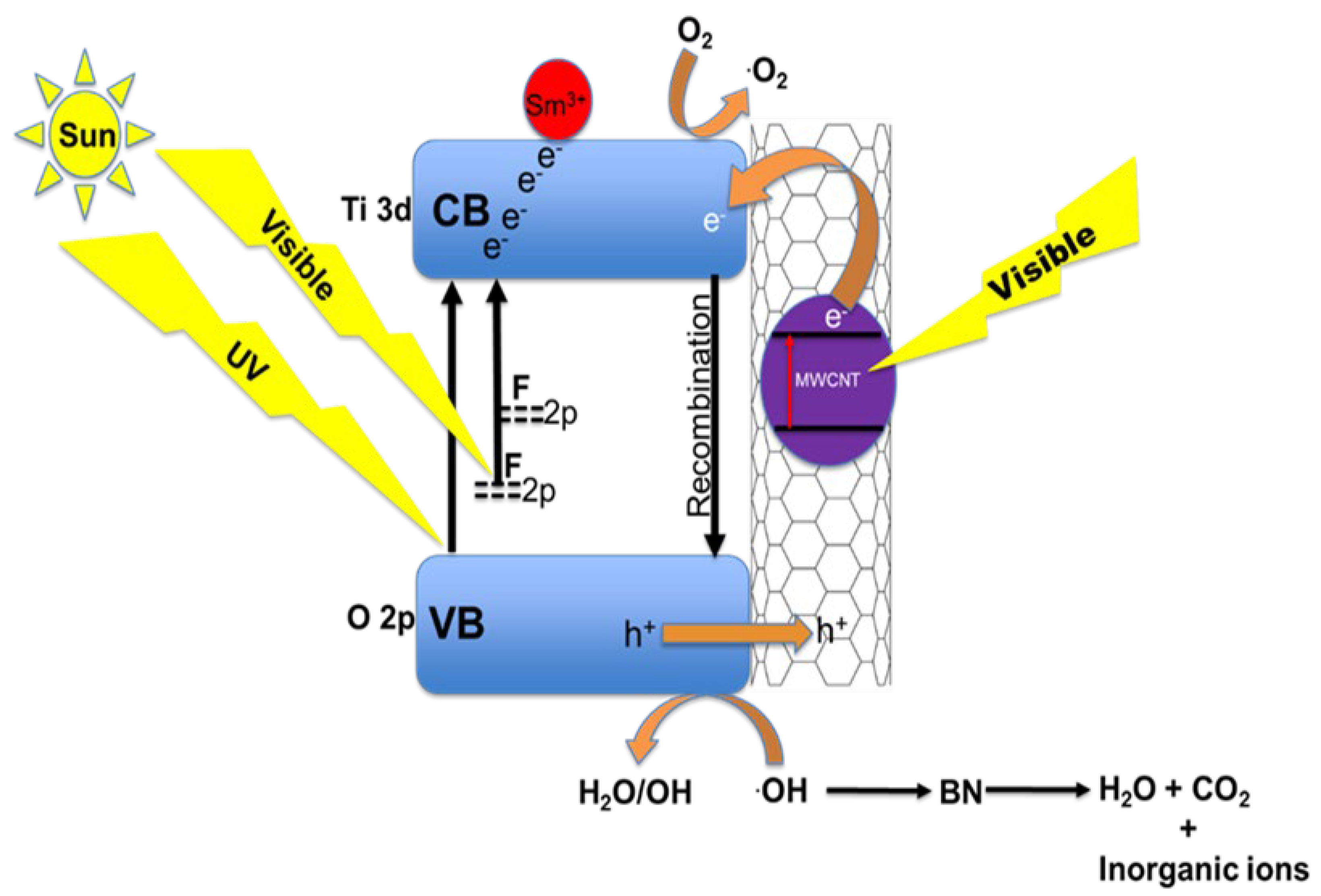
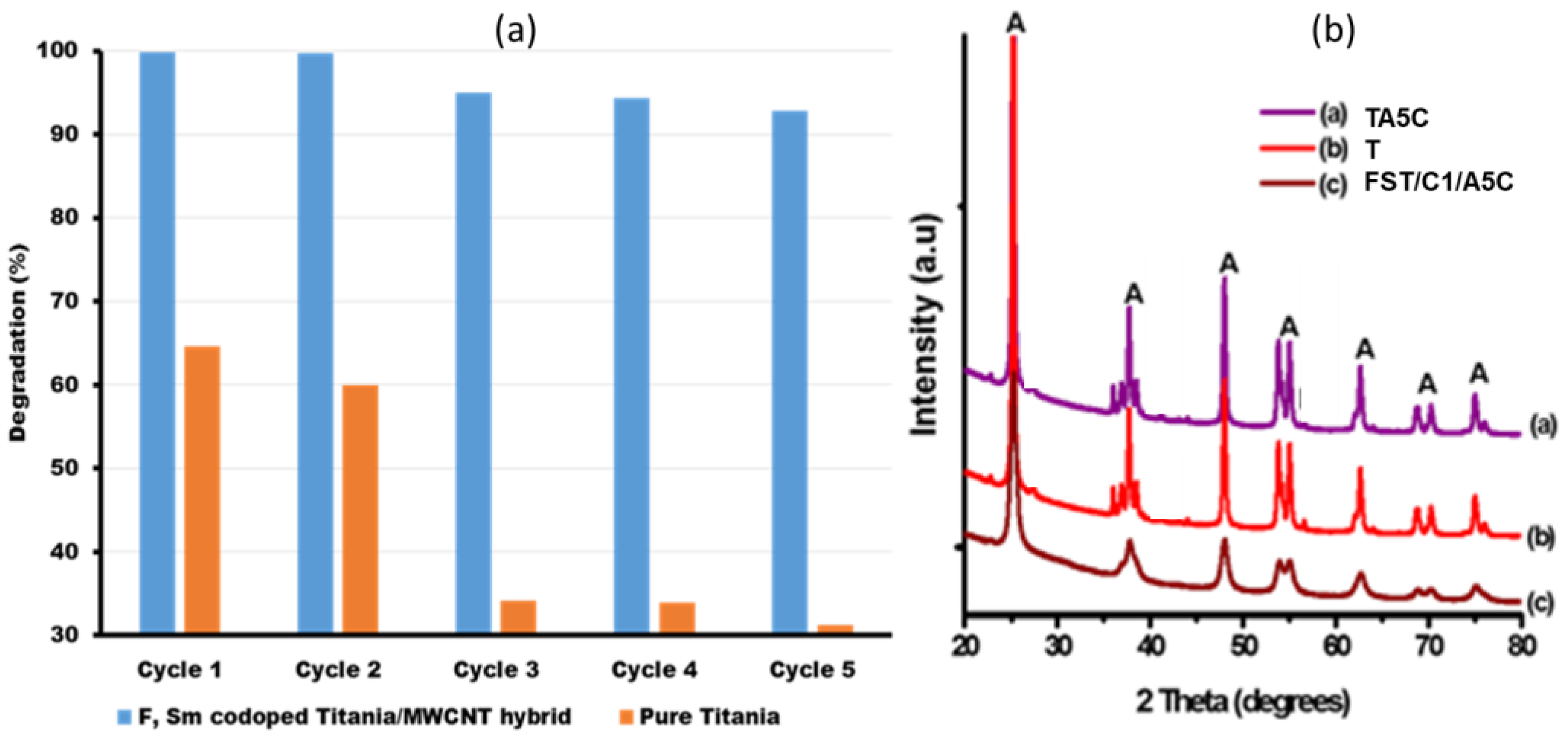
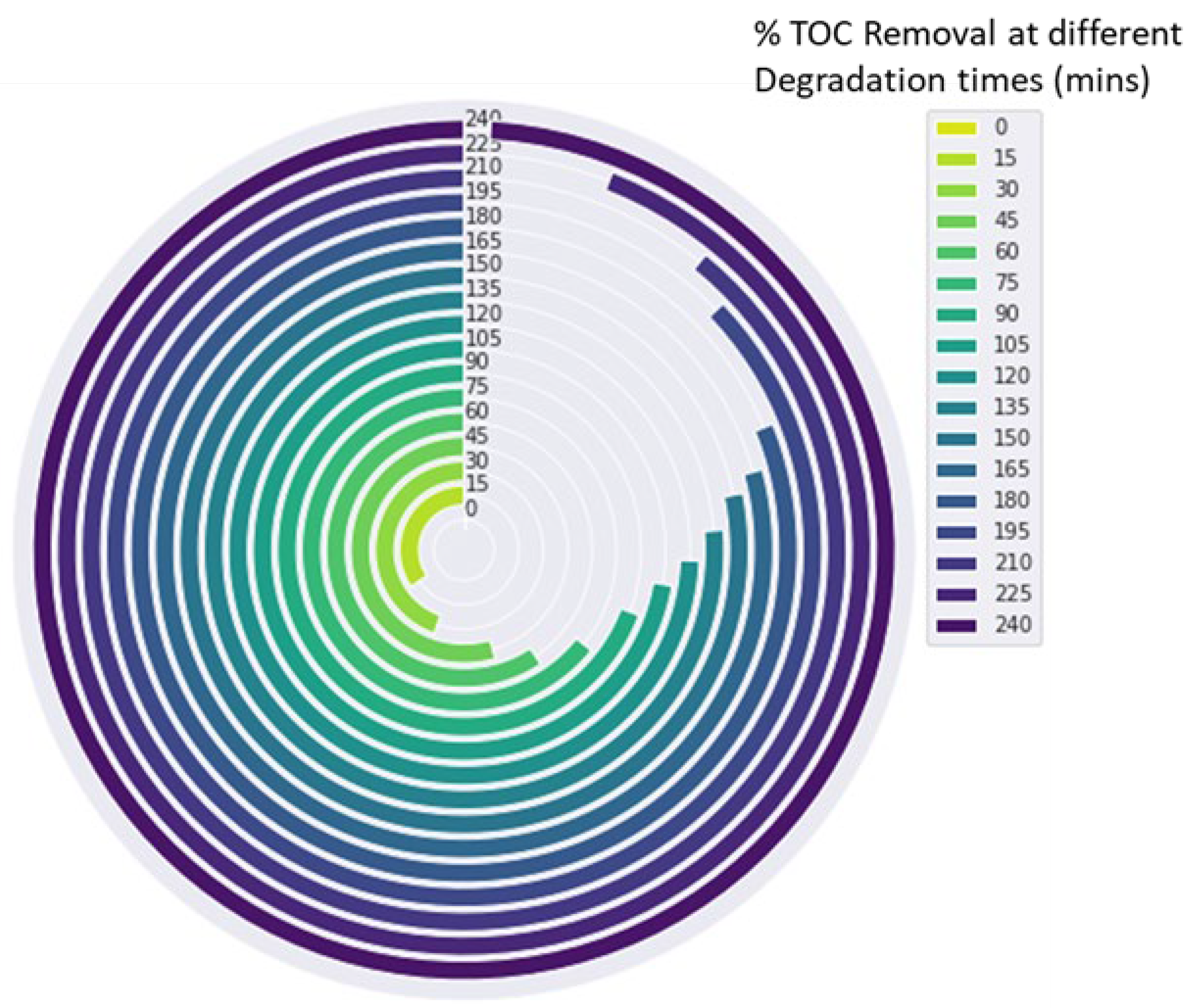

| Sample | Absorption Wavelength [nm] | Band Gap (Eg) [eV] |
|---|---|---|
| FST3 | 517 | 2.40 |
| FST3/C1 | 525 | 2.36 |
| FST3/C2 | 520 | 2.38 |
| FST3/C3 | 540 | 2.29 |
| FST3/C4 | 550 | 2.25 |
| Sample | Crystallite Size (D) [nm] | Lattice Strain (η) |
|---|---|---|
| FST3 | 15.45 | 0.0107 |
| FST3/C1 | 17.72 | 0.0093 |
| FST3/C2 | 17.72 | 0.0093 |
| FST3/C3 | 18.10 | 0.0091 |
| FST3/C4 | 18.49 | 0.0089 |
| Sample | SSA [m2/g] |
|---|---|
| 98% MWCNT * | 216 |
| FST3 | 19.4 |
| FST3/C1 | 47.9 |
| FST3/C2 | 50.7 |
| FST3/C3 | 57.1 |
| FST3/C4 | 61.8 |
| Sample | Degradation Rate after 120 min [%] | Rate Constant (Ka) [min−1] |
|---|---|---|
| FST3 | 93.1 | 2.18 × 10−2 |
| FST3/C1 | 100.0 | 3.70 × 10−2 |
| FST3/C2 | 98.5 | 2.76 × 10−2 |
| FST3/C3 | 91.9 | 1.94 × 10−2 |
| FST4/C4 | 79.0 | 1.25 × 10−2 |
| Sample | Target Dye Pollutant | Initial Concentration [mg/L] | Source of Light | PC Kapp [min−1] | Ref |
|---|---|---|---|---|---|
| N,S-Nd3+-TiO2-MWCNT | Eosin blue shade | 20 | Visible | 1.4 × 10−2 | [31] |
| N,S-Nd3+-TiO2-MWCNT | Eriochrome Black T | 20 | Visible | 8.0 × 10−3 | [31] |
| N, Pd3+-TiO2-MWCNT | Eosin Yellow | 100 | Solar | 3.42 × 10−2 | [36] |
| N, Pd3+-TiO2-MWCNT | Eosin Yellow | 100 | Visible | 5.18 × 10−3 | [36] |
| N,S-Nd3+-TiO2-SWCNT | Eosin blue shade | 20 | Visible | 1.5 × 10−2 | [38] |
| N,S-Nd3+-TiO2-MWCNT | Naphthol blue black | 20 | Visible | 1.33 × 10−2 | [46] |
| F, Sm3+-TiO2-MWCNT | Brilliant Black BN | 50 | Solar | 2.73 × 10−2 | Our study |
| Sample | Initial Mass [g] | Final Mass [g] | Recovery [%] |
|---|---|---|---|
| T | 0.102 | 0.062 | 60.8 |
| FST3/C1 | 0.1 | 0.91 | 91 |
| Sample | Notation |
|---|---|
| Pristine TiO2 | T |
| F, Sm3+ co-doped TiO2 (0.6% Sm3+) | FST3 |
| F, Sm3+ co-doped TiO2 (0.6% Sm3+)/0.25%MWCNT | FST3/C1 |
| F, Sm3+ co-doped TiO2 (0.6% Sm3+)/0.5%MWCNT | FST3/C2 |
| F, Sm3+ co-doped TiO2 (0.6% Sm3+)/0.75%MWCNT | FST3/C3 |
| F, Sm3+ co-doped TiO2 (0.6% Sm3+)/1%MWCNT | FST3/C4 |
| Pristine TiO2 after 5-cycle use | TA5C |
| F, Sm3+ co-doped TiO2 (0.6% Sm3+)/0.25%MWCNT after 5-cycle use | FST3/C1/A5C |
Disclaimer/Publisher’s Note: The statements, opinions and data contained in all publications are solely those of the individual author(s) and contributor(s) and not of MDPI and/or the editor(s). MDPI and/or the editor(s) disclaim responsibility for any injury to people or property resulting from any ideas, methods, instructions or products referred to in the content. |
© 2022 by the authors. Licensee MDPI, Basel, Switzerland. This article is an open access article distributed under the terms and conditions of the Creative Commons Attribution (CC BY) license (https://creativecommons.org/licenses/by/4.0/).
Share and Cite
Mukonza, S.S.; Chaukura, N.; Mishra, A.K. Photocatalytic Activity and Reusability of F, Sm3+ Co-Doped TiO2/MWCNTs Hybrid Heterostructure for Efficient Photocatalytic Degradation of Brilliant Black Bis-Azo Dye. Catalysts 2023, 13, 86. https://doi.org/10.3390/catal13010086
Mukonza SS, Chaukura N, Mishra AK. Photocatalytic Activity and Reusability of F, Sm3+ Co-Doped TiO2/MWCNTs Hybrid Heterostructure for Efficient Photocatalytic Degradation of Brilliant Black Bis-Azo Dye. Catalysts. 2023; 13(1):86. https://doi.org/10.3390/catal13010086
Chicago/Turabian StyleMukonza, Sabastian Simbarashe, Nhamo Chaukura, and Ajay Kumar Mishra. 2023. "Photocatalytic Activity and Reusability of F, Sm3+ Co-Doped TiO2/MWCNTs Hybrid Heterostructure for Efficient Photocatalytic Degradation of Brilliant Black Bis-Azo Dye" Catalysts 13, no. 1: 86. https://doi.org/10.3390/catal13010086
APA StyleMukonza, S. S., Chaukura, N., & Mishra, A. K. (2023). Photocatalytic Activity and Reusability of F, Sm3+ Co-Doped TiO2/MWCNTs Hybrid Heterostructure for Efficient Photocatalytic Degradation of Brilliant Black Bis-Azo Dye. Catalysts, 13(1), 86. https://doi.org/10.3390/catal13010086










